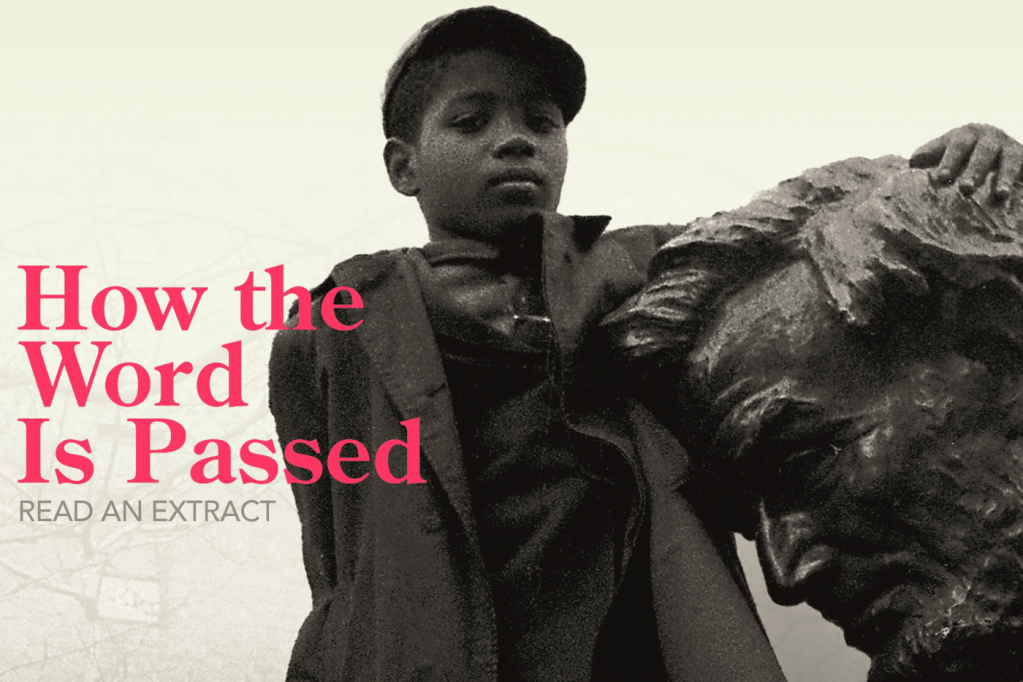How the Word is Passed: Read an Extract

Beginning in his hometown of New Orleans, Clint Smith leads the reader on an unforgettable tour of monuments and landmarks – those that are honest about the past and those that are not – which offer an intergenerational story of how slavery has been central in shaping a nation’s collective history, and our own.
It is the story of the Monticello Plantation in Virginia, the estate where Thomas Jefferson wrote letters espousing the urgent need for liberty while enslaving more than four hundred people. It is the story of the Whitney Plantation, one of the only former plantations devoted to preserving the experience of the enslaved people whose lives and work sustained it. It is the story of Angola, a former plantation-turned-maximum-security prison in Louisiana that is filled with Black men who work across the 18,000-acre land for virtually no pay. And it is the story of Blandford Cemetery, the final resting place of tens of thousands of Confederate soldiers.
A deeply researched and transporting exploration of the legacy of slavery and its imprint on centuries of American history, How the Word Is Passed illustrates how some of our most essential stories are hidden in plain view – whether in places we might drive by on our way to work, holidays such as Juneteenth or entire neighbourhoods like downtown Manhattan, where the brutal history of the trade in enslaved men, women and children has been deeply imprinted.
‘How the Word is Passed is a landmark book that offers a new understanding of the hopeful role that memory and history can play in making sense of the United States. Chosen as a book of the year by President Barack Obama, The Economist, Time, the New York Times and more, fans of Brit(ish) and Natives will be utterly captivated.
‘A beautifully readable reminder of how much of our urgent, collective history resounds in places all around us that have been hidden in plain sight.’ Afua Hirsch, author of Brit(ish)
‘How the Word Is Passed frees history, frees humanity to reckon honestly with the legacy of slavery. We need this book.’ Ibram X. Kendi, #1 New York Times bestselling author
* * * * *
“The whole city is a memorial to slavery”
PROLOGUE
The sky above the Mississippi River stretched out like a song. The river was still in the windless afternoon, its water a yellowish- brown from the sediment it carried across thousands of miles of farmland, cities, and suburbs on its way south. At dusk, the lights of the Crescent City Connection, a pair of steel cantilever bridges that cross the river and connect the east and west banks of New Orleans, flickered on. Luminous bulbs ornamented the bridges’ steel beams like a congregation of fireflies settling onto the backs of two massive, unbothered creatures. A tugboat made its way downriver, pulling an enormous ship in its wake. The sounds of the French Quarter, just behind me, pulsed through the brick sidewalk underfoot. A pop-up brass band blared into the early-evening air, its trumpets, tubas, and trombones commingling with the delight of a congregating crowd; a young man drummed on a pair of upturned plastic buckets, the drumsticks in his hands moving with speed and dexterity; people gathered for photos along the river’s edge, hoping to capture an image of themselves surrounded by a recognizable piece of quintessential New Orleans iconography.
After the transatlantic slave trade was outlawed in 1808, about a million people were transported from the upper South to the lower South. More than one hundred thousand of them were brought down the Mississippi River and sold in New Orleans.
Leon A. Waters came and stood next to me on the riverfront, hands in pockets, lips compressed, overlooking the Mississippi’s slow bend between the two shores of the city. I had been introduced to Waters by a group of young Black activists in New Orleans who were part of the organization Take ’Em Down NOLA, whose self-espoused mission is “the removal of ALL symbols of white supremacy in New Orleans as a part of a broader push for racial & economic justice.” Waters has served as a mentor to many members of the group — they see him as an elder statesman of their movement and credit him for being a central part of their political education.
Waters — in his late sixties with a greying mustache sitting over his lips — wore a black sports coat over a grey-and-white-striped shirt with the top button undone. A navy-blue tie hung loosely below his unfastened collar and swung over the waistband of his faded blue jeans. A pair of thin-framed, rectangular-shaped glasses sat high on the bridge of his nose, the left lens with a slight smudge in its bottom corner. His voice was low and unvarying in its tone. Waters might be mistaken for surly, but his disposition is simply a reflection of the seriousness with which he takes the subject matter he often is discussing, the subject of slavery.
We were standing in front of a plaque, recently put up by the New Orleans Committee to Erect Markers on the Slave Trade, outlining Louisiana’s relationship to the transatlantic slave trade. “It’s doing its job,” Waters said of the plaque. “All through the day people come in, they stop, they read, take pictures . . . It’s another way of educating people to this.”
In recent years, markers like this began to go up through- out the city, each documenting a specific area’s relationship to enslavement — part of a broader reckoning. After years of Black people being killed by police and having their deaths broadcast in videos streamed across the world, after a white supremacist went into a Black church in Charleston, South Carolina, and killed nine people as they prayed, after neo-Nazis marched in Charlottesville,
Virginia, to protect a Confederate statue and reclaim a history born of a lie, after George Floyd was killed by a police officer’s knee on his neck, cities across the country have begun to more fully reckon with the history that made such moments possible — a history that many had previously been unwilling to acknowledge. Waters, who identifies as a local historian and revolutionary, was not new to this. He and others like him have, for years, been work- ing to illuminate the city’s legacy — and by extension the country’s legacy — of oppression.
Only recently, after decades of pushing by activists, amid the larger groundswell of national pressure, have city officials begun to listen, or perhaps feel like they finally have the political capital to act. In 2017, New Orleans removed four statues and monuments that, it had determined, paid tribute to the legacy of white suprem- acy. The city removed memorials to Robert E. Lee, the general who led the Confederacy’s most successful army during the Civil War, a slaveholder; Jefferson Davis, the first and only president of the Confederacy, a slaveholder; P. G. T. Beauregard, a general in the Confederate Army who ordered the first shots of the Civil War, a slaveholder; and a monument dedicated to the Battle of Liberty Place, an 1874 insurrection in which white supremacists attempted to overthrow the integrated Reconstruction-era state government of Louisiana. These monuments are gone now, but at least a hundred streets, statues, parks, and schools named after Confederate figures, slaveholders, and defenders of slavery remain. On a cool February afternoon, Waters, the founder of Hidden History Tours of New Orleans, promised to show me where some of these vestiges of the past remain.
Waters drove me past two schools named after John McDonogh, a wealthy slave-owning merchant after whom dozens of schools, filled largely with Black children, were named until the 1990s; we drove past shops and restaurants and hotels where there once had been the offices, showrooms, and slave pens of more than a dozen slave-trading firms that made New Orleans the largest slave market
in antebellum America — like the Omni Royal Orleans Hotel, built on the site of the St. Louis Hotel, where men, women, and children were bought, sold, and separated from one another; we drove past Jackson Square, in the heart of the tourist-filled French Quarter, where rebellious enslaved people were executed.
Even the street on which Waters dropped me off at the end of our tour, where my parents now live, is named after Bernard de Marigny, a man who owned more than 150 enslaved people over the course of his lifetime. The echo of enslavement is everywhere. It is in the levees, originally built by enslaved labor. It is in the detailed architecture of some of the city’s oldest buildings, sculpted by enslaved hands. It is in the roads, first paved by enslaved people. As historian Walter Johnson has said about New Orleans, “The whole city is a memorial to slavery.”
New Orleans is my home. It is where I was born and raised. It is a part of me in ways I continue to discover. But I came to realize that I knew relatively little about my hometown’s relation- ship to the centuries of bondage rooted in the city’s soft earth, in the statues I had walked past daily, the names of the streets I had lived on, the schools I had attended, and the buildings that had once been nothing more to me than the remnants of colonial architecture. It was all right in front of me, even when I didn’t know to look for it.
It was in May 2017 — after the statue of Robert E. Lee near downtown New Orleans had been taken down from its sixty-foot pedestal — that I became obsessed with how slavery is remembered and reckoned with, with teaching myself all of the things I wish someone had taught me long ago. Our country is in a moment, at an inflection point, in which there is a willingness to more fully grapple with the legacy of slavery and how it shaped the world we live in today. But it seems that the more purposefully some places have attempted to tell the truth about their proximity to slavery and its aftermath, the more staunchly other places have refused. I wanted to visit some of these places — those telling the truth, those
running from it, and those doing something in between — in order to understand this reckoning.
In How the Word Is Passed I travel to eight places in the United States as well as one abroad to understand how each reckons with its relationship to the history of American slavery. I visit a mix of plantations, prisons, cemeteries, museums, memorials, houses, his- torical landmarks, and cities. The majority of these sites are in the South, as this is where slavery was most saturated over the course of its nearly two-hundred-fifty-year existence on these shores, but I also travel to New York City and Dakar, Senegal. Each chapter is a portrait of a place but also of the people in that place — those who live there, work there, and are the descendants of the land and of the families who once lived on it. They are people who have tasked themselves with telling the story of that place outside traditional classrooms and beyond the pages of textbooks. They are, formally or informally, public historians who carry with them a piece of this country’s collective memory. They have dedicated their lives to sharing this history with others. And for this book, many of them have generously shared that history with me.
ONE OF BARACK OBAMA'S FAVOURITE BOOKS OF THE YEAR
A NUMBER ONE NEW YORK TIMES BESTSELLER
LONGLISTED FOR THE NATIONAL BOOK AWARD FOR NON-FICTION
'A beautifully readable reminder of how much of our urgent, collective history resounds in places all around us that have been hidden in plain sight.' Afua Hirsch, author of Brit(ish)
Beginning in his hometown of New Orleans, Clint Smith leads the reader on an unforgettable tour of monuments and landmarks - those that are honest about the past and those that are not - which offer an intergenerational story of how slavery has been central in shaping a nation's collective history, and our own.
It is the story of the Monticello Plantation in Virginia, the estate where Thomas Jefferson wrote letters espousing the urgent need for liberty while enslaving more than four hundred people. It is the story of the Whitney Plantation, one of the only former plantations devoted to preserving the experience of the enslaved people whose lives and work sustained it. It is the story of Angola, a former plantation-turned-maximum-security prison in Louisiana that is filled with Black men who work across the 18,000-acre land for virtually no pay. And it is the story of Blandford Cemetery, the final resting place of tens of thousands of Confederate soldiers.
A deeply researched and transporting exploration of the legacy of slavery and its imprint on centuries of American history, How the Word Is Passed illustrates how some of our most essential stories are hidden in plain view - whether in places we might drive by on our way to work, holidays such as Juneteenth or entire neighbourhoods like downtown Manhattan, where the brutal history of the trade in enslaved men, women and children has been deeply imprinted.
How the Word is Passed is a landmark book that offers a new understanding of the hopeful role that memory and history can play in making sense of the United States. Chosen as a book of the year by President Barack Obama, The Economist, Time, the New York Times and more, fans of Brit(ish) and Natives will be utterly captivated.
What readers are saying about How the Word is Passed:
'How the Word Is Passed frees history, frees humanity to reckon honestly with the legacy of slavery. We need this book.' Ibram X. Kendi, Number One New York Times bestselling author
'An extraordinary contribution to the way we understand ourselves.' Julian Lucas, New York Times Book Review
'The detail and depth of the storytelling is vivid and visceral, making history present and real.' Hope Wabuke, NPR
'This isn't just a work of history, it's an intimate, active exploration of how we're still constructing and distorting our history." Ron Charles, The Washington Post
'In re-examining neighbourhoods, holidays and quotidian sites, Smith forces us to reconsider what we think we know about American history.' Time
'A history of slavery in this country unlike anything you've read before.' Entertainment Weekly
'A beautifully written, evocative, and timely meditation on the way slavery is commemorated in the United States.' Annette Gordon-Reed, Pulitzer Prize-winning author







